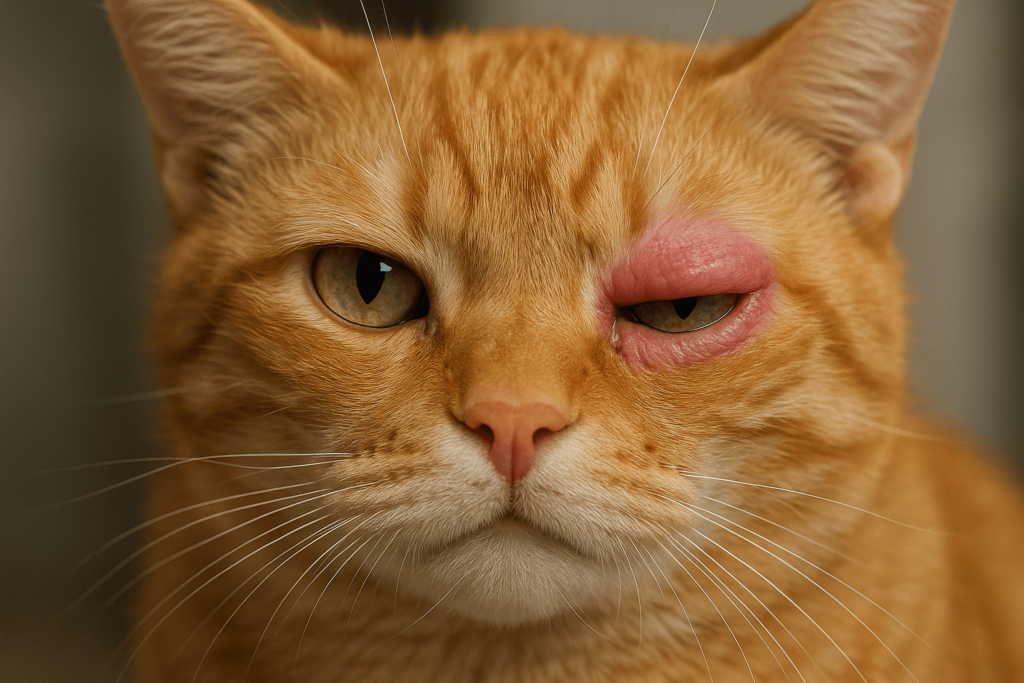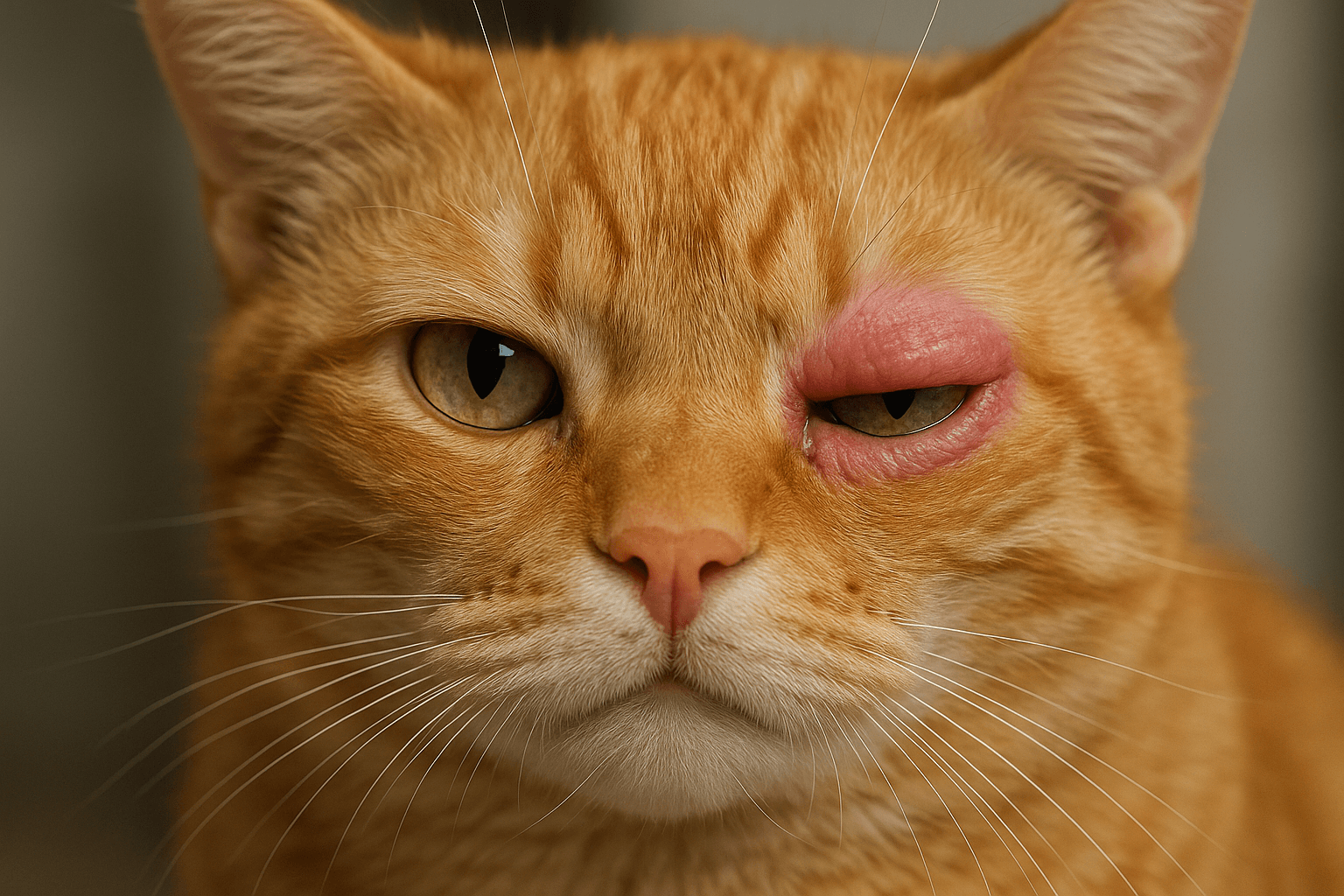Cat Upper Eyelid Swollen? Don’t Ignore This Subtle Warning Sign
A swollen upper eyelid in your cat isn’t just a cosmetic concern—it’s a silent alarm. Cats rarely show pain openly, so when you notice puffiness around their eye, it’s often the first—and sometimes only—visible clue that something’s wrong. Whether it’s mild irritation or a serious infection, this symptom demands attention. Understanding the causes, recognizing the urgency, and knowing how to respond can make all the difference in your cat’s recovery.
Why a Swollen Upper Eyelid Is Never “Just a Bump”
Swelling in a cat’s upper eyelid isn’t random. It’s a physical response to an underlying issue—often one that’s progressing beneath the surface. Here’s what’s likely happening:
Allergic Reaction:
Exposure to pollen, dust, cleaning products, or even new food can trigger localized inflammation around the eye.Infection (Bacterial or Viral):
Conjunctivitis, upper respiratory viruses like feline herpesvirus, or bacterial infections cause swelling, discharge, and discomfort.Foreign Object:
A piece of grass, seed, or eyelash trapped under the lid can cause intense irritation and rapid swelling.Trauma or Injury:
A scratch from play, a fall, or a fight with another animal can lead to bruising, fluid buildup, or abscess formation.Tumor or Growth:
Though less common, benign or malignant growths can develop on or under the eyelid, causing persistent, asymmetrical swelling.
This isn’t something to “wait and see.” Even if your cat seems fine otherwise, eyelid swelling often signals a problem that worsens quickly without intervention.

The Most Common Medical Causes Behind Swollen Cat Eyelids
Not all swelling is created equal. The cause determines the treatment—and the urgency. Here’s how to distinguish the most frequent culprits:
Feline Herpesvirus (FHV-1):
A highly contagious virus that causes recurrent upper respiratory infections. Swelling is often accompanied by watery discharge, sneezing, and lethargy.Conjunctivitis (Pink Eye):
Inflammation of the membrane lining the eyelid. Can be viral, bacterial, or allergic—always causes redness and swelling of the upper and lower lids.Chalazion or Meibomian Gland Blockage:
A clogged oil gland on the eyelid forms a painless lump that swells over days. Often mistaken for a stye.Abscess from Bite Wound:
Especially common in outdoor cats. A small puncture from a fight can hide a pus-filled pocket that swells the eyelid dramatically within 24–48 hours.Entropion or Eyelid Malformation:
A congenital or age-related condition where the eyelid rolls inward, causing constant irritation and secondary swelling.
Each of these requires a different approach. Misdiagnosing one for another can delay healing—or make things worse. Always consult your vet for an accurate diagnosis.
Check this guide 👉Understanding Cat Eyes Anatomy: Best 7 Expert Tips!
Check this guide 👉Cat Eye Inflammation: Best 7 Expert Tips!
Check this guide 👉Understanding Cat Eye Mites: Best 7 Expert Tips!
| Symptom | Likely Cause |
|---|---|
| Sudden, painful swelling after a fight | Abscess from bite wound |
| Swelling with watery discharge and sneezing | Feline herpesvirus or URI |
| Red, itchy eyelid with crusty discharge | Bacterial conjunctivitis |
| Painless, firm lump along eyelid margin | Chalazion or meibomian gland cyst |
| Swelling that worsens over weeks, no other symptoms | Tumor (benign or malignant) |
What You Should Never Do When Your Cat’s Eyelid Is Swollen
It’s natural to want to help—but many well-intentioned home remedies can do more harm than good. Avoid these common mistakes:
Never Apply Human Eye Drops:
Products like Visine or allergy drops are toxic to cats and can cause severe corneal damage.Don’t Squeeze or Poke the Swelling:
This can rupture an abscess internally, spread infection, or damage delicate eye structures.Avoid Home Remedies Like Tea Bags or Coconut Oil:
These may seem soothing, but they introduce bacteria, clog glands, or trigger allergic reactions.Don’t Wait for “It to Go Away on Its Own”:
Many eye conditions in cats progress rapidly. Delaying treatment risks permanent vision damage.Never Ignore Other Symptoms:
If your cat is squinting, rubbing their face, or has a fever, this isn’t mild—it’s urgent.
Your cat’s eyes are incredibly sensitive. What looks like a small bump could be a gateway to blindness if mishandled.
How to Safely Monitor and Provide First Aid at Home
While professional care is essential, you can take gentle, safe steps to support your cat until you reach the vet:
Keep the Area Clean:
Gently wipe away discharge with a sterile, damp cotton ball—use a fresh one for each eye to avoid cross-contamination.Prevent Rubbing:
Use an Elizabethan collar (cone) if your cat is pawing at their eye. Scratching can cause ulcers or deeper injury.Maintain a Calm Environment:
Reduce stress, bright lights, and loud noises. Stress suppresses immune function and slows healing.Monitor for Changes:
Take a photo daily. Note if swelling increases, changes color, or if your cat stops eating or becomes lethargic.Keep Them Indoors:
Prevent exposure to allergens, insects, or other cats that could worsen the condition.
These aren’t treatments—they’re supportive measures. The goal is to stabilize your cat while you prepare for veterinary care.
When to Rush to the Vet: Critical Red Flags
Some signs mean you need to leave for the clinic today—not tomorrow. These are emergencies:
Eye Is Partially or Fully Closed:
This indicates severe pain or corneal ulceration.Discharge Is Yellow, Green, or Pus-Like:
Signs of active bacterial infection requiring antibiotics.Third Eyelid Is Protruding:
Known as “haw,” this is a classic sign of systemic illness or nerve damage.Your Cat Is Rubbing Their Face Violently or Screaming:
Indicates extreme pain or a foreign body embedded in the eye.Swelling Spreads to the Face or Nose:
Suggests a deep infection, such as a tooth root abscess, that’s spreading.
If you see any of these, call your vet on the way. Time is vision—and your cat’s comfort depends on immediate action.
Diagnosis and Treatment: What to Expect at the Vet
Your vet won’t guess—they’ll investigate. Here’s what typically happens during an eye exam:
Fluorescein Stain Test:
A dye is applied to check for corneal scratches or ulcers—common with trauma or infections.Schirmer Tear Test:
Measures tear production to rule out dry eye, which can mimic swelling.Swab or Culture:
If infection is suspected, a sample is taken to identify bacteria or viruses.Bloodwork or Allergy Testing:
For chronic or unexplained swelling, systemic issues like FIV, FeLV, or allergies are checked.Ultrasound or Biopsy:
If a tumor is suspected, imaging or tissue sampling may be needed.
Treatment varies: antibiotics, antivirals, anti-inflammatories, surgery for abscesses or tumors, or allergy management. Most cats respond well when treated early.
Preventing Future Episodes of Eyelid Swelling
Once your cat recovers, prevention is key. Protect their delicate eyes with these proactive steps:
Keep Vaccinations Up to Date:
Especially for feline herpesvirus and calicivirus—major causes of recurrent eye issues.Limit Outdoor Access:
Reduces risk of fights, insect bites, and exposure to allergens or toxins.Use Pet-Safe Cleaning Products:
Avoid strong sprays, perfumes, or aerosols near your cat’s face.Regular Grooming and Nail Trims:
Prevents accidental scratches to the eye during self-grooming or play.Schedule Annual Eye Exams:
Especially for older cats or breeds prone to eye problems (Persians, Himalayans).
Prevention isn’t about control—it’s about respect. Respecting your cat’s vulnerability means protecting their world from preventable harm.
FAQ: Cat Upper Eyelid Swollen
Can a cat’s swollen eyelid be caused by allergies?
Yes. Environmental allergens like pollen, mold, or dust mites can cause localized swelling, often accompanied by itching or watery eyes.
Is it safe to use saline solution on my cat’s eye?
Yes—if it’s sterile, preservative-free saline. Use it gently to rinse away debris. Never use tap water or homemade solutions.
My cat’s eyelid swelled after a flea treatment—could that be the cause?
Possibly. Some topical flea products can cause localized irritation if applied incorrectly or if your cat is sensitive. Wash the area gently and contact your vet.
Can a cat get a stye like humans do?
Yes—it’s called a chalazion. It’s a blocked oil gland on the eyelid. It’s usually painless but needs veterinary evaluation to rule out infection.
Will the swelling go down on its own?
Sometimes, if it’s mild and caused by a temporary irritant. But if it lasts more than 24–48 hours, or if your cat seems uncomfortable, assume it’s not going away without help.
Your Cat’s Eyes Are a Window to Their Health
A swollen upper eyelid may seem small—but in a cat’s world, it’s a shout. It’s their way of saying, “I’m not okay,” when they can’t tell you in words. Ignoring it isn’t kindness. It’s risk.
You don’t need to be a vet to notice the change. You just need to care enough to act.
To hold your cat gently, to wipe their eye with a clean cloth, to call the vet without hesitation—that’s love in action.
Canned Pumpkin for Cat Diarrhea: Best 7 Expert Tips! Natural remedy to firm stools, soothe upset bellies, and support gut health safely.
Can a Cat Give You Scabies? Best 7 Expert Tips! Discover the truth about feline mites, human skin risks, and how to protect yourself—without panic.
Cat Flea vs Human Flea: Best 7 Expert Tips! Discover the truth about bites, species, and how to eliminate infestations for good.
Weird Cat Behaviors: Best 7 Expert Tips! Discover why cats do strange things—and how to understand, not punish, their instincts for a happier home.





